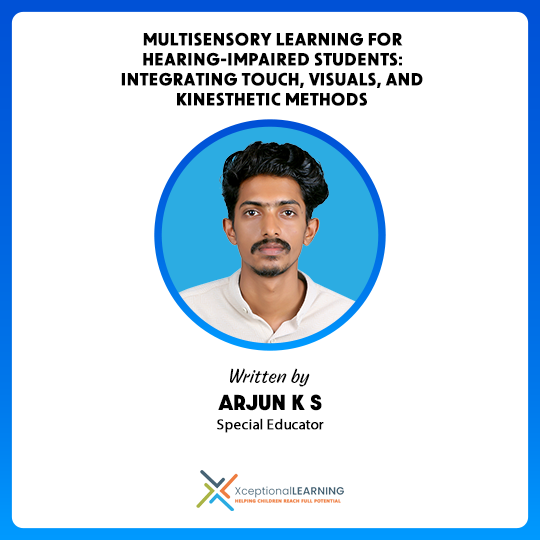Multisensory Learning for Hearing-Impaired Students: Integrating Touch, Visuals, and Kinesthetic Methods
admin November 19th, 2025

Written By
Arjun K S
Special Educator
Introduction
Imagine a classroom alive with colour, texture, and motion — where learning is seen, touched, and felt. For hearing-impaired learners, this is not just education; it is a symphony of senses playing in harmony. Multisensory learning transforms silence into strength by making education immersive, engaging, and accessible.
- Multisensory learning turns traditional teaching into an interactive journey.
- It uses sight, touch, and movement to deepen understanding.
- Helps bridge communication gaps for hearing-impaired learners.
- Encourages children to not just learn, but experience knowledge.
The Power of Multisensory Learning
For hearing-impaired students, who naturally rely more on sight and touch, engaging multiple senses opens new pathways to comprehension. By tapping into these strengths, educators can make abstract concepts concrete, bridge communication barriers, and support inclusive learning environments.
Enhances Engagement:
When lessons include visual aids, tactile materials, and movement-based activities, learning becomes interactive and meaningful.
Improves Retention:
Concepts are remembered better when learners can see, touch, and physically interact with them.
Bridges Communication Gaps:
Visual cues, sign language support, and tactile tools offer non-auditory ways to access and internalize information.
Encourages Active Participation:
Multisensory instruction invites curiosity and hands-on involvement, motivating students to explore ideas beyond the textbook.
Visual Learning: Seeing Is Understanding
For hearing-impaired students, vision becomes the bridge to knowledge. Studies show that nearly 70% of what they learn comes through sight, making visual learning not just a preference, but a necessity.
Effective Visual Strategies Integrated with Technology
- Smartboards and Tablets:
Interactive screens bring lessons to life with diagrams, animations, and real-time collaboration. - Captioned Videos and Sign-Language Lessons:
These tools ensure every learner can access auditory content visually. - Visual Storytelling and Simulations:
Digital stories, infographics, and simulations transform abstract concepts into concrete understanding. - Digital Platforms:
Apps and online tools encourage students to explore content independently.
Benefits:
- Strengthens comprehension through clear visual cues.
- Enhances learning through animations and real-time demonstrations.
- Promotes inclusive and engaging classroom experiences.
Tactile Learning: Learning Through Touch
For hearing-impaired students, tactile learning provides a concrete way to link abstract ideas with real-world experiences. This approach engages multiple senses, making learning more interactive, memorable, and accessible.
Effective Tactile Strategies Integrated with Technology
- Virtual Labs and 3D Simulations:
These tools recreate hands-on experiments digitally, allowing students to manipulate virtual objects. - Blending Real and Digital Experiences:
Combining real objects with digital visuals or simulations helps reinforce theoretical concepts. - Touch-Based Learning Tools:
Interactive digital activity books enable students to drag, trace, and manipulate virtual elements through touch.
Benefits:
- Improves comprehension and memory.
- Strengthens fine motor skills and spatial understanding.
- Encourages active engagement and curiosity.
Kinesthetic Learning: Learning by Doing
For hearing-impaired students, movement and physical engagement become essential gateways to understanding. This approach makes learning concrete and memorable in every classroom.
How Digital Tools Help Kinesthetic Learning
- Integration of Movement and Technology:
Digital platforms that incorporate physical interaction—like motion sensors or gesture-based learning—promote active participation and engagement. - Virtual Simulations and Motion-Based Activities:
These allow students to perform experiments, explore environments, or practice real-life tasks by moving and interacting, even in digital spaces. - Body Actions and Visual Feedback:
By combining movement with on-screen responses, students gain immediate visual feedback, reinforcing understanding through both body and sight.
Benefits:
- Promotes active, experiential learning.
- Boosts concentration and memory through movement.
- Builds confidence by connecting physical actions to learning outcomes.
How XceptionalLEARNING Connects Multisensory Learning in Hearing-Impaired Students
The XceptionalLEARNING platform enables children to learn through multisensory approaches using digital activity books and smart classrooms. This approach represents an excellent example of hybrid teaching, integrating both traditional and digital methods. XceptionalLEARNING moves education toward a fully hybrid system, creating an effective and inclusive learning model for hearing-impaired students.
Smart Classrooms in XceptionalLEARNING
- Child-focused, engaging content projected on large screens for clarity and enjoyment.
- Integration of interactive whiteboards and multimedia for hands-on, dynamic lessons.
- Flexible learning enabled by digital tools catering to diverse learning preferences.
- Real-time progress tracking allows personalized instruction adjustments.
- Collaborative communication tools connect students, teachers, and parents seamlessly.
Digital Activity Book (VergeTAB)
- Teachers send personalized content and worksheets directly to students.
- Vivid visuals, animations, and diagrams enhance visual learning.
- Touchscreen features allow manipulation, supporting tactile engagement.
- Movement-based tasks and simulations promote kinesthetic learning.
- Interactive, hands-on experiences deepen concept understanding.
XceptionalLEARNING Platform
- Engages visual, tactile, and kinesthetic senses through animations and interactive activities.
- Encourages collaboration in online sessions for active participation.
- Reinforces learning through motivating task-based systems.
- Extends learning to the home through digital activity books.
- Involves parents in monitoring progress and supporting home practice.
Hybrid Learning Approach
- Combines digital tools with traditional methods for effective learning.
- Uses digital visuals with real objects to strengthen understanding.
- Merges tactile and digital learning through 3D models and simulations.
- Provides flexible, personalized learning for diverse student needs.
- Ensures accessibility, engagement, and continuity through online and offline integration.
Conclusion
Multisensory learning represents a transformative approach in the education of hearing-impaired children. By strategically integrating visual, tactile, and kinesthetic modalities, this method compensates for auditory limitations and promotes deeper cognitive engagement. Such approaches not only facilitate comprehension and retention of complex concepts but also nurture active participation and emotional connection to learning. Moreover, the incorporation of digital and assistive technologies further enhances accessibility and inclusivity within the classroom environment. Ultimately, multisensory learning fosters an equitable educational experience, empowering hearing-impaired learners to develop holistically and achieve their full academic and personal potential.
Empower your child’s learning journey with multisensory education. Contact us today for comprehensive Child Development Support, and connect with licensed therapists online. Explore our Hybrid Therapy Services and expand therapy practice online for a seamless, inclusive, and engaging learning experience.

